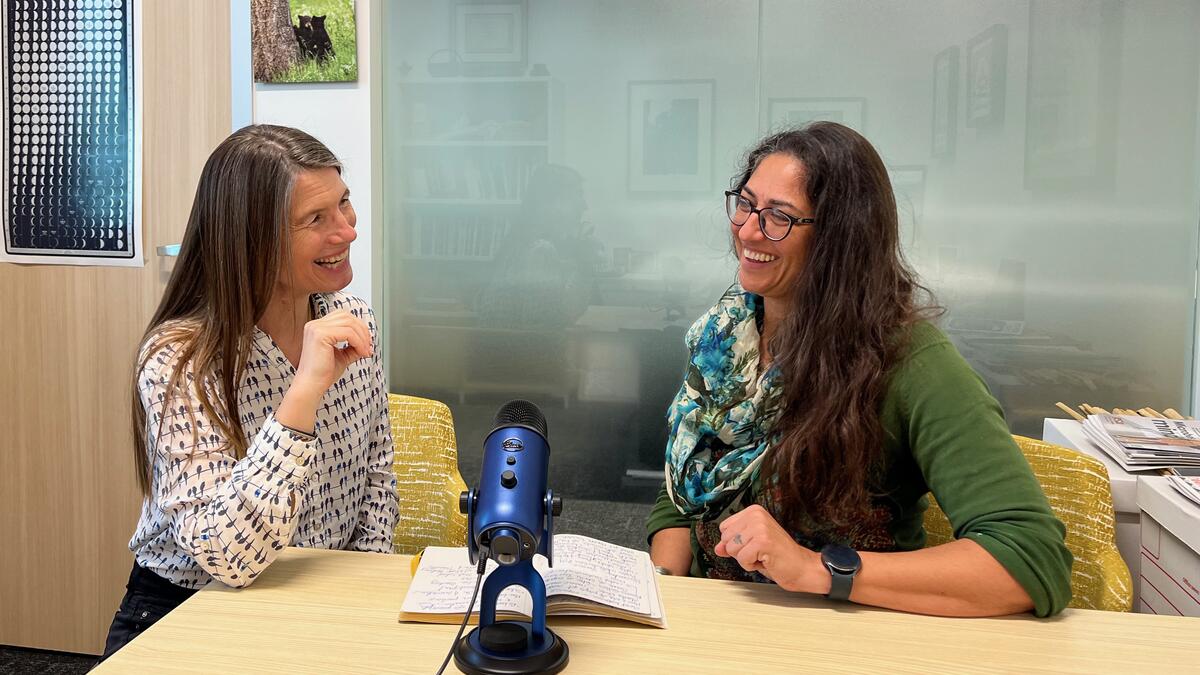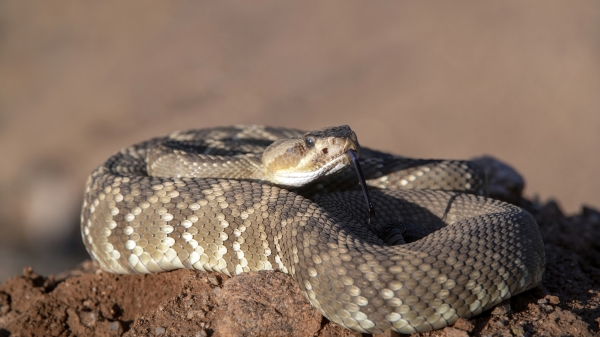New ASU podcast looks at biomimicry through an Indigenous lens

Arizona State University professors Melissa Nelson (left) and Sara El-Sayed have created a new podcast titled "Knowledge Symbiosis: Can Biomimicry and Indigenous Science Harmonize." The five-episode series invites dialogue from multiple perspectives, including practitioners in biomimicry, elders and Indigenous scholars. Photo by Sophie Neems
The topic of biomimicry isn’t your typical water cooler conversation, but two Arizona State University professors are attempting to make the subject more accessible to the public and explore if it can facilitate more inclusive pathways to science.
“Knowledge Symbiosis: Can Biomimicry and Indigenous Science Harmonize” is a five-episode podcast series recently produced by The Cultural Conservancy’s Native Seed Pod in collaboration with Arizona State University.
The series is currently available on The Native Seed Pod and Learning from Nature: The Biomimicry Podcast.
Hosted by Sara El-Sayed, co-director of the Biomimicry Center and an assistant research professor at the Swette Center for Sustainable Food Systems; Melissa Nelson, professor of Indigenous sustainability in the School of Sustainability; and Lily Urmann, program coordinator for the Biomimicry Center, the podcast invites dialogue from multiple perspectives — including practitioners in biomimicry, elders and Indigenous scholars.
ASU News spoke to El-Sayed and Nelson about the origins of the podcast and why they are using this medium to bring understanding to the field.
Question: We hear the word biomimicry tossed around a lot, but I get the feeling many truly don’t know the true definition. What’s a good baseline definition of this word?
El-Sayed: Biomimicry is the conscious emulation of nature’s genius. Nature has evolved the most adaptable strategies, and as human designers, we can gain inspiration from these strategies to create systems that are sustainable and even regenerative.
To be true biomimics, we also need to learn how to reconnect to nature, be part of it and have an ethos that guides us to be well-adapted to this Earth.
Q: How is Indigenous sustainability related to the field of biomimicry?
Nelson: Indigenous peoples, all over the world, have historically worked to harmonize their lifeways, cultural practices and economies within the rhythms and limits of their local places. These sustainable and regenerative place-based practices are rooted in worldviews that see the Earth and all its life as intelligent and worthy of respect.
In fact, many Native cultures see the natural world not only as intelligent, but sacred and essential to human survival and well-being because of our inherent kinship.
These time-tested Indigenous ways of knowing and relating to the Earth are sources of inspiration for biomimicry as it attempts to transform Western science and design modern cultural systems based on the intelligence of natural processes.
It could be said that Indigenous peoples are the original biomimics who align their cultural practices with local ecosystems.
Q: How did the two of you come up with this idea and why did you choose a podcast to explore this topic?
El-Sayed: Both Melissa and I had an interest in each other’s field of work. I graduated with a master's (degree) in biomimicry but had been heavily involved in Egypt on traditional food production, so when I came to the U.S. for my PhD, I continued this interest in weaving nature-inspired design with Indigenous knowledge — and this is where I first met Melissa.
We have been closely discussing the potential of what would it take for us to bring these worlds together, and we figured that the best way is to have honest conversations and to tell stories — and what better way than a podcast? Melissa also happens to host a fantastic podcast herself, and I produced a series of podcasts for my dissertation. We then brought Lily Urmann as co-host, who has her biomimicry podcast called “Learning From Nature,” and "Knowledge Symbiosis" was born.
Q: What have you learned or what were some key findings from your interviews?
Nelson: It’s been fascinating to hear all the different perspectives on biomimicry and Indigenous science by biomimicry practitioners and different Indigenous scholars, farmers and educators. Even though everyone comes from unique perspectives, and they all happened to be women, there was a true spirit of cooperation and inclusion; folks thought these different knowledges could be symbiotic, mutually supportive in solving everything from soil erosion and food security to the types of housing we live in and how we educate children.
Ultimately, this is a new language and methodology rooted in ancient philosophies, and a potential paradigm shift in how people relate to the natural world.
But there were real concerns, too, about power and economics, and who benefits from biomimetic inventions, and who is possibly harmed in the process. So ethics and justice are key. It’s important to think about how biomimicry is being implemented and how it can benefit Indigenous communities and other marginalized groups.
Q: I also understand you are putting together an in-person gathering on biomimicry. Can you tell us more about that?
El-Sayed: Melissa and I received a National Science Foundation-funded grant to host a “Gathering to Create Culturally Relevant Biomimicry Pathways to STEM for Indigenous Students.” The conversation will be hosted at ASU’s Old Main and the Salt River Pima Maricopa Indian Community on Feb. 16–17.
The gathering invites students, educators, academics, elders and community members to reflect on how to increase Indigenous students in science, technology, engineering and math/medicine, and whether given biomimicry’s nature connection, if it can be a pathway for Indigenous students into STEM. In that process, we will also explore how biomimicry can be more culturally relevant so that this pathway can indeed be accessible.
Q: What are the next steps for this collaboration?
Nelson: Sara and I have gathered a lot of information from the "Knowledge Symbiosis" podcast series in the form of stories, case studies, dreams and concerns. We are also gathering a lot of insights and questions from our in-person gathering. We will collect and process this “harvest of ideas” and report back to our communities and professions in the form of in-person meetings and presentations, a written report and article, and possibly other multimedia productions.
We are interested in developing a class on the topic, possibly some community workshops and focusing on key areas to explore more deeply with additional research grants and collaborative action projects.
More Environment and sustainability

ASU launches groundbreaking partnership to address water insecurity in Arizona
For the past two years, Arizona has contended with record-breaking heat and over 1,000 heat-related deaths in Maricopa County alone. However, the county is just a microcosm of the rest of the…

There's a rattlesnake in your backyard: What do you do?
A snake slithers onto your back porch one sunny morning.What do you do?Call a relocation expert, grab a shovel and try to kill the reptile, or do nothing?That moral quandary is at the center of…

Pettinger to guide Southwest Sustainability Innovation Engine's sustainable technologies to market
There’s a lot of daylight between coming up with a good idea and turning that idea into something people can use.Katie Pettinger is here to help bridge that considerable gap. As the new chief…